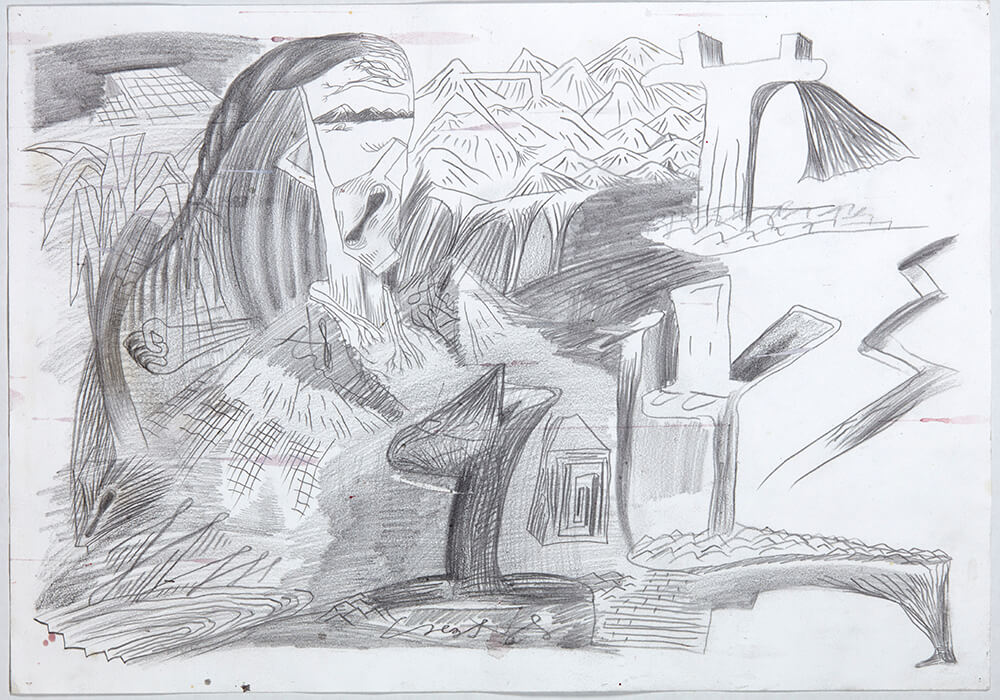The Bill Hammond drawings illustrated in this article will be included in Bowerbank Ninow’s upcoming Auction No.6, which will be accompanied by an auction catalogue containing essays by a range of leading New Zealand art writers, including Andrew Paul Wood. For more information, visit the website or follow us on social media.
Lyttelton-based artist Bill Hammond needs very little introduction, given his unassailable position among New Zealand’s blue-ribbon investment artists. While he is popularly known for his lush, atmospheric canvases populated by melancholic human-bird hybrids, awaiting taxidermic colonisation in their Edenic landscape, this has only been the dominant theme in his work since the 1990s, inspired by a 1989 visit to the to the bird-encrusted Auckland Islands as part of the Art in the Sub-Antarctic project. Hammond’s ’80s works drink up the caffeinated energy of punk, rock ‘n’ roll, surrealism, graffiti, cartoons and other unexpected sources, all gleefully short-circuiting each other, rife with conspiratorial, antic paranoia and rebellion against suburban conservatism — reflecting the two sides of Christchurch’s coin in the 1970s and ‘80s.
For all the talk of the Garden City’s much-touted ‘Englishness’, this label also contains within it gothic, punk and grunge sensibilities (music plays an important role in Hammond’s life and work), as well as a tolerance for eccentricity. Where the bird-men are contemplative and solemn, pre-1990 Hammond Land seethed and fizzed with anarchy, paradox and mutability, striking sparks of startling originality off the alluvial gravel of Canterbury’s braided riverbeds. He presents us with an entire iconography, the syntax of which seems just out of reach. Perhaps Hammond forces us to wrestle with these problems as a reflection of the struggle with identity taking place during the ‘80s, as identity politics and economic uncertainty flourished in New Zealand, later than elsewhere.
Hammond’s drawings are fascinating for what they reveal about his painting. In their flatness and their concentration on outline rather than modelling, even the large and highly finished paintings are perhaps more accurately described as drawings with paint. The drawings are not subordinate to the paintings, it is merely that the medium has changed and the vivid colours been subtracted, though there is an immediacy and spontaneity to the graphite or pencil mark that gives them their own validity, authenticity and appeal.

Hammond’s drawing has been compared to doodling. There are certainly elements of automatic drawing to it, a core principle of surrealist art (and a few spiritualist mediums) in which the hand is permitted to move randomly across the paper as a way of tapping into the subconscious. These automatic impulses provide a flexible and plastic framework on which Hammond hangs his familiar motifs: the coiled fronds, the grimaces, the sinister biomechanical forms, the bones, the oddly angled limbs almost parodying ancient Egyptian wall paintings, the mountains, fists, Hokusai waves, hot rod tailpipes, and ropes. Hammond moves effortlessly from one sign to the next without being in any sense awkward or disjointed; the drawing is less a mediation between hand and eye, than between hand and fecund imagination.
The physicality of the drawn mark and the materiality of its substance, combined with drawing’s gradual assimilation into digital technologies, gives these works further levels of poignancy. When we also consider that Hammond is frequently touted as ‘New Zealand’s most important living artist’— a mantle pushed on to Ralph Hotere, Gordon Walters and Colin McCahon at various points, too heavy and ornate to be born comfortably — the drawings take on a ‘future old-master’ quality.
As objects, the drawings run the risk of becoming picayune relics of celebrity and a name rather than the frisky pieces of casual genius they really are. As the ability to draw is becoming less and less an important part of contemporary art practice, these fascinating works remind us of drawing’s immediacy, power, fluency, versatility and command.
Words: Andrew Paul Wood






